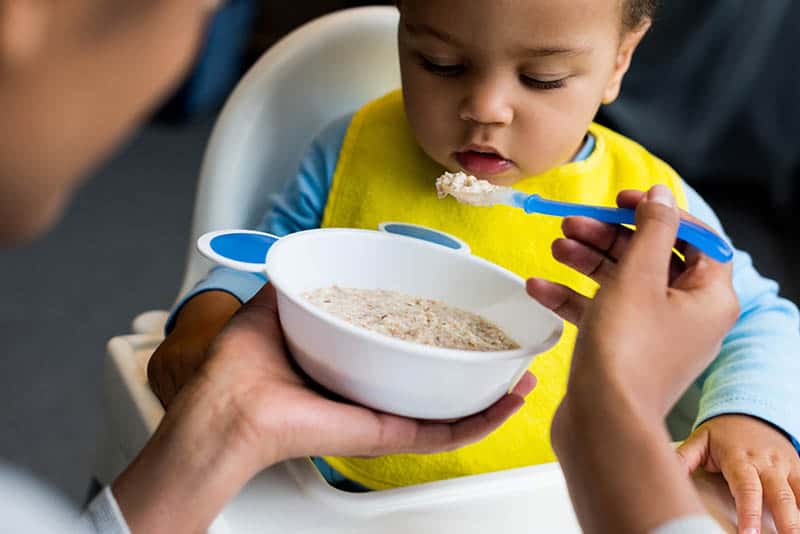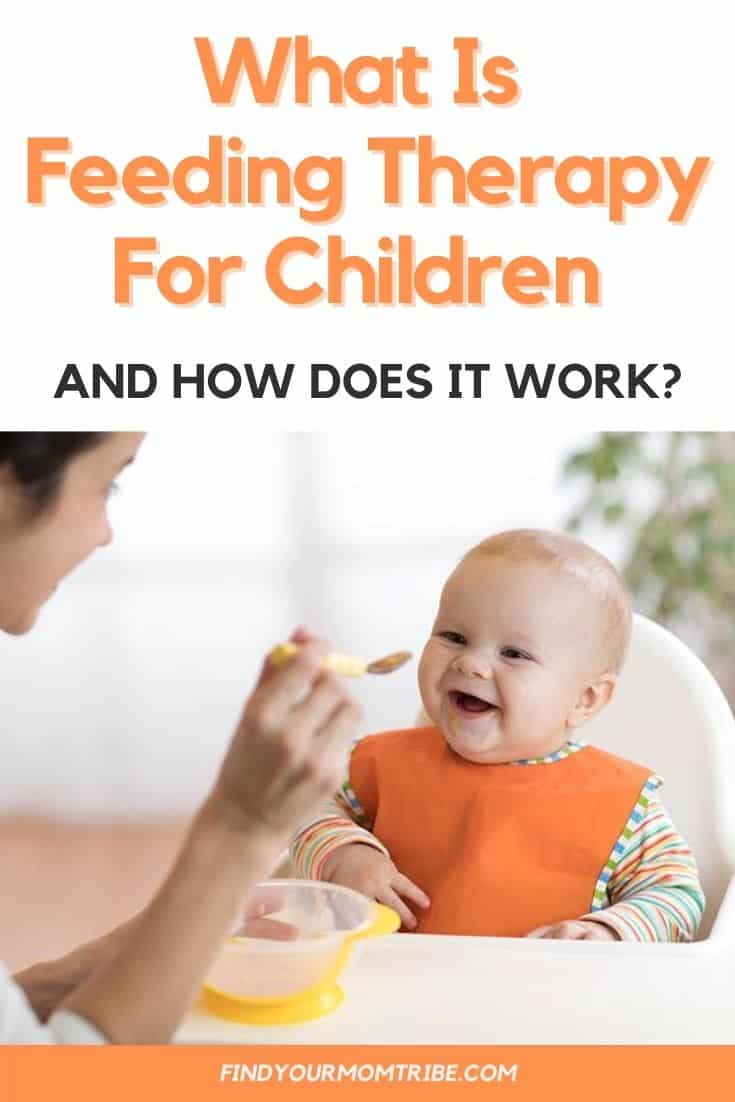If your child’s eating problems have become so extreme that you are considering asking for professional help, then you will definitely benefit from feeding therapy. But how can you know that it’s right for your child?
Feeding therapy is designed for children who have extreme feeding issues, either as a result of a medical condition, disorder, or extreme pickiness that doesn’t allow them to enjoy food in the same way as the rest of their peer group.
A key person in this process is the feeding or occupational therapist, who is specially trained to work with such children and teach them to have a positive relationship with food so that eating is no longer such a struggle.
But the parents are also vital during the therapy sessions as they need to learn the proper techniques to implement at home to help their child continue to make progress.
This kind of therapy is not reserved for a specific age group and even babies can take part.
That being said, let’s learn more about this kind of therapy, who is eligible for it, and some useful feeding tricks you can try at home.
What is feeding therapy?

When a toddler or child has issues with eating, they might need professional help to improve their eating habits and make mealtime more successful.
This kind of feeding therapy is performed by a variety of professionals specializing in this field – feeding therapists, occupational therapists, and even speech-language pathologists.
The therapist will work with your child to address their feeding issues during their therapy sessions.
In addition, they will create an individualized plan that will focus on the needs of your child and the underlying causes that prevent him from enjoying food like the rest of his age group, for example.
While you can try to learn specific techniques to make mealtime easier at home, only a therapist trained to work with children with feeding problems should be entrusted to treat your child.
This doesn’t mean that you will be completely excluded from the process, quite the contrary – the therapist will give you all the information you need to help your child eat at home.
Your child might have their therapy sessions every week, ranging from half an hour to an hour in length.
The sessions will be one-on-one or in a group setting, depending on the kind of approach taken by the therapist.
It’s important that you take your child to all of their appointments so that they can make progress.
How can I know if my child needs it?

While there are children who have medical conditions that pose a feeding challenge, children who are picky eaters or have other issues are also eligible for this kind of therapy.
If your child frequently exhibits any of the symptoms below while eating, then you should consider talking to a doctor about your next course of action:
- Vomits, gags, or chokes during or right after meals;
- Shows difficulty when drinking from an open cup;
- Pushes or moves away from food;
- Excessive fussiness while eating;
- Food refusal, especially with new foods;
- Struggles with chewing their food and swallowing it;
- Has respiratory infections often;
- Gaining weight is a struggle;
- Has trouble breathing properly while eating;
- Has a preference for only one food texture and refuses others, such as only accepting bottle feedings and refusing solids during feeding sessions;
- In the case of babies, there is an inability to properly suck, swallow, and breathe in a regular pattern.
If you suspect that your child might need this kind of therapy, your first point of contact should be your pediatrician.
Let them know about your concerns, especially if your child hasn’t been gaining weight well.
They will refer you to a therapist who will perform a detailed feeding evaluation to get to the root of the issue.
You can expect the therapist to ask what your child eats on a daily basis or maybe even for a list of all the foods he eats in the span of a few days.
Let them know if your child has had any medical conditions, such as a lip tie.
They will also observe your child while he eats foods he likes and, more importantly, foods he does not like as well as check how he responds to messy play.
They will likely check his oral motor skills by observing how he chews and drinks from a cup, bottle, or breast if he’s breastfeeding.
Generally speaking, the following conditions may require your child to take part in feeding therapy:
- Your child has an autism spectrum disorder that makes eating difficult;
- He wasn’t exposed or introduced to a variety of foods on time;
- He has a digestive disorder;
- He has a sensory processing disorder;
- He is an extremely picky eater.
Regardless of the underlying cause that is making eating food difficult for your child, or even if you aren’t sure of what it could be, don’t hesitate to request an evaluation by a therapist from your pediatrician.
As good nutrition is the backbone of the healthy development of children, this is not something you should postpone.
What is considered an extremely picky eater?

Parents use the term picky eating often when they talk about their kids. In the majority of cases, however, they mean that their kids might not like all kinds of baby food or don’t like to eat vegetables or fruit.
As a baby transitions to eating solid foods and baby food such as purees, it’s perfectly normal to see a certain level of pickiness.
Toddlers and kids can also have preferences towards certain foods and refuse to eat others, but this doesn’t mean that every meal is a struggle or that you need a professional to step in.
If you aren’t sure whether your child belongs in the extreme picky eating category, see if he is displays any of the following symptoms:
- Gagging or vomiting when presented with new kinds of food;
- Throws a tantrum when you try to give him new foods to eat and it escalates beyond what is expected for his age group;
- There is only a handful of foods that he will actually eat – no more than 20;
- Requires a specific meal to be prepared just for him because he won’t eat what the rest of the family is having;
- Can’t eat at social gatherings because the meal needs to be prepared or served in a specific way;
- Needs distractions to eat – they can come in the form of videos, toys, music;
- Refuses self-feeding even though he is old enough to eat on his own;
- Food has to look a certain way or be from a specific brand;
- Doesn’t respond to bargaining or being asked to take a bite.
Having just one of these symptoms does not an extremely picky eater make – all kids have their own quirks that go away with time – but if you recognize your child in at least half of these scenarios, then he does belong to this group and would benefit from a therapy program.
Many parents think that such extreme feeding difficulties will disappear on their own as their child gets older. Unfortunately, this is usually not true.
There is a risk that the problem will escalate, making it harder to keep their child well-fed and happy at the same time.
For instance, he might suddenly stop eating what used to be one of his favorite snacks, narrowing down the number of things he will eat.
In addition, partaking in family activities outside the home will be a challenge and the child will likely struggle to take part in social gatherings such as birthdays or sleepovers because food will become such a major issue.
What to expect from a feeding program

Once you get in touch with a feeding specialist to start your child’s therapy, you will probably be curious about the kind of program they’ll put together.
The main goal of such therapy is to focus on developing specific skills that will improve how the child eats and develop a positive relationship with food, rather than turn it into a daily struggle.
The therapist could aim to create a positive eating experience in cases where the child needs therapy because they’ve learned to associate food with something negative as a result of a sickness, food allergies, or another cause.
In this process, the therapist will break the negative associations with mealtime and help the child feel more confident by teaching him how to eat and drink on his own using cups, forks, spoons, and straws.
Another important step in creating a positive relationship with food is educating the parents or the primary caregivers on how to not undo the progress made during the therapy sessions.
This is important because although feeding therapists are trained to be patient, the caregivers might not show the same level of understanding at home, so developing feeding techniques is in order.
If the child has poor oral motor skills that are causing feeding issues, then the therapist will work on improving them specifically. These skills are part of the very important fine motor skills we develop as children.
During therapy sessions, the child will learn how to properly chew and swallow food, as well as how to drink.
Children who need to improve their oral motor skills will often be trained by a speech therapist because speaking also requires the use of the same motor skills so they are already experienced in this field through speech therapy.
As a result of sensory issues or another problem, some children will eat only a very limited amount of food so the therapist will work with them on expanding the kinds of food they will consume.
They will learn self-feeding skills and how to enjoy food of different textures, shapes, and colors in order to overcome their food aversions.
This is a great strategy for children who are very picky about their food because it will open doors to more nutritious meals.
Plus, the rest of the family will be able to enjoy meals both at home and restaurants or social gatherings without the fear that their child will go hungry.
For infants, a special program is in order.
Depending on whether you are bottle-feeding or breastfeeding your baby, the therapist will find a way of improving mealtime.
Breastfed babies might need to improve their latch while bottle-fed babies might need a different nipple.
The therapist will also work on their suck-swallow-breathe pattern if this is at the root of the problem.
Feeding disorders can be difficult to handle on your own and they can have a severe impact on your child’s health and development, making it necessary to find a qualified therapist who will create a feeding program tailored to your child’s needs.
But you can also be an active participant in your child’s feeding program and become an important link between the sessions with the therapist and eating at home.
For example, you can make a record of what your child eats, whether there were any improvements, how he reacts to new food, etc.
The therapist will also work with you and show you how to practice with the child at home.
Remember – your child won’t be very successful unless he applies what he has learned during therapy at home.
A few red flags to look out for in feeding therapy

Unfortunately, not every feeding therapist has the best approach when it comes to teaching your child to eat a variety of foods and could have a very negative impact on his progress.
Many therapists have different approaches and it’s worth spending some extra time researching the ones available in your area to see how they compare and whether they have experience with children that have issues similar to your child.
Even though approaches vary, there are a few red flags that will let you know if the therapist’s approach is subpar:
- The evaluation isn’t thorough. You are only asked to fill in a form, without giving very specific information pertaining to your child’s eating habits, medical history, or anything else that could influence his feeding issues;
- The therapist asks you to stay outside during the session. Parents should learn the techniques the therapist is using to apply at home, otherwise, the sessions might not work at all. In addition, your child could be traumatized by someone else attempting to feed him, creating even more negative associations with food.
- The therapist doesn’t pay attention to your opinions or concerns. Even though a therapist is a professional trained in this field, you are still the child’s parent who has been by their side since birth. If you suspect that a particular issue could be behind your child’s feeding problems, then the therapist should make sure to examine it.
- Your child appears to be very anxious before therapy to the point where he might feel sick. This could be an indication that he does not feel good in the presence of his therapist.
Before choosing to enroll your child in a particular therapist’s program, don’t be afraid to ask any and all questions that come to mind. Perhaps they have a sample video of what a typical session looks like?
Could they refer you to the parents of other children who have taken part in their program? What kind of strategies do they use with children who reject their feeding techniques?
Getting answers to such questions will give you a good insight into the therapist’s strategy and techniques even before your child steps into their office and give you peace of mind knowing that your child is in good hands.
Tips for feeding therapy at home

Although you should leave the bulk of the work to the professionals, knowing a few useful tips to incorporate this kind of therapy at home can be invaluable as you work to find the best therapist for your child.
First off, watch how your child responds to a particular food, and when he starts to show signs of rejecting it, don’t force him to have “just one more bite”.
Instead, put the food away and try with another one before the child has a chance to get too worked up.
Even though it’s obvious, it’s very important that you or whoever is in charge of feeding your child stays calm and patient during feedings.
Children are quick to pick up on your mood and if you are frustrated or angry, you can rest assured that it will transfer to your child, too.
If your child is old enough, encourage him to help you make food in the kitchen and make him a part of the experience. Ask him to take his own plate to the table and set his fork, spoon, and so on.
But if he’s not comfortable using a fork or a spoon to eat, allow him to eat with his hands or use whatever makes him comfortable – no need to insist on table manners now.
The same applies to eating from a bowl or plate.
Sometimes a child simply won’t eat from whatever you served the food in, so it’s okay for you to dump it right on the high chair or table if you suspect that could work.
For drinks, pour them in a clear cup so that your child can see what’s inside before drinking as a non-translucent cup can be a big source of anxiety.
When introducing changes to their food, do it gradually.
Let’s say your child enjoys eating lemon cookies but doesn’t like bananas. You can gently introduce bananas by mashing one up and putting a tiny bit onto the cookies.
It’s also possible to prepare the food he likes in different ways but again without any drastic changes. Add a small amount of one spice to a vegetable he likes or cook it or cut it up differently.
If you have a new food you would like him to try, don’t offer it during the main meal, like dinner, but try giving it to him as a snack.
This takes the pressure of eating enough food during the meal out of the equation.
While your child is eating, don’t worry about cleaning up until after mealtime. The same goes for your clothes getting dirty, so it’s best to wear something you don’t mind getting stained.
If your child is really resistant to trying one type of food, then you will need to encourage him to explore it in ways that don’t involve consuming it.
With cooked rice, for example, he can play with it and get used to the texture using his hands only.
During the process, he might become curious enough to give it a try but the key is to break the negative association.
Finally, don’t insist that your child eats at the dinner table or in their high chair every time.
His memories of eating in the kitchen or the dining room might be negative, so taking him outside of that environment can be very helpful and encourage him to eat his food.
Final thoughts
What is most important to realize about feeding therapy is that it can help your child overcome their problems with food and allow them to not see mealtimes as something to dread.
On the other hand, children who need this kind of therapy are not spoiled or just being picky – they have serious conditions or disorders that make them averse, and sometimes even afraid, of certain foods.
These conditions usually don’t go away with time and can be even harder to manage as the child gets older, so getting therapy is vital to give your child a chance at a regular life where they’re not afraid to eat food that is outside of their comfort zone.
Having patience during this process is absolutely invaluable and it might take months to see progress. But when it happens, you will be over the moon, so don’t delay talking to your pediatrician about getting an evaluation for your child.
I hope you were able to learn more about this special kind of therapy and that you feel more confident to tackle this issue!
Like this post? Please share or pin it for later. You can also stay in the loop and follow us on Facebook, Instagram and Pinterest.

This post contains affiliate links. Please see our full disclosure or more info.

